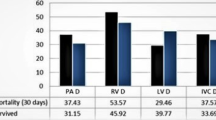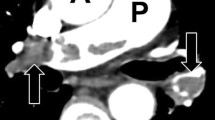Abstract.
The objective was to evaluate the helical CT (HCT) criteria that could indicate severe pulmonary embolism (PE). In a retrospective study, 81 patients (mean age 62 years) with clinical suspicion of PE explored by HCT were studied. The patients were separated into three different groups according to clinical severity and treatment decisions: group SPE included patients with severe PE based on clinical data who were treated by fibrinolysis or embolectomy (n=20); group NSPE included patients with non-severe PE who received heparin (n=30); and group WPE included patients without PE (n=31). For each patient we calculated a vascular obstruction index based on the site of obstruction and the degree of occlusion in the pulmonary artery. We noted the HCT signs, i.e., cardiac and pulmonary artery dimensions, that could indicate acute cor pulmonale. According to multivariate analysis, factors significantly correlated with the severity of PE were: the vascular obstruction index (group SPE: 54%; group NSPE: 24%; p<0.001); the maximum minor axis of the left ventricle (group SPE: 30.2 mm; group NSPE: 40.4 mm; p<0.001); the diameter of the central pulmonary artery (group SPE: 32.4 mm; group NSPE: 28.3 mm; p<0.001); the maximum minor axis of the right ventricle (group SPE: 47.5 mm; group NSPE: 42.7 mm; p=0.029); the right ventricle/left ventricle minor axis ratio (group SPE: 1.63; group NSPE: 1.09; p<0.0001). Our data suggest that hemodynamic severity of PE can be assessed on HCT scans by measuring four main criteria: the vascular obstruction index; the minimum diameter of the left ventricle; the RV:LV ratio; and the diameter of the central pulmonary artery.

Similar content being viewed by others
References
Lilienfeld DE, Chan E, Ehland J et al. (1990) Mortality from pulmonary embolism in the United States: 1962 to 1984. Chest 98:1067–1072
Bankier AA, Janata K, Fleischmann D et al. (1997) Severity assessment of acute pulmonary embolism with spiral CT: evaluation of two modified angiographic scores and comparison with clinical data. J Thorac Imaging 12:150–158
Rémy-Jardin M, Remy J, Artaud D, Deschildre F, Duhamel A (1997) Peripheral pulmonary arteries: optimization of the spiral CT acquisition protocol. Radiology 204:157–163
Goodman LR, Curtin JJ, Mewissen MW et al. (1995) Detection of pulmonary embolism in patients with unresolved clinical and scintigraphic diagnosis: helical CT versus angiography. Am J Roentgenol 164:1369–1374
Qanadli SD, El Hajjam M, Viellard-Baron A et al. (2001) New CT index to quantify arterial obstruction in pulmonary embolism: comparison with angiographic index and echocardiography. Am J Roentgenol 176:1415–1420
Blum AG, Delfau F, Grignon B et al. (1994) Spiral-computed tomography versus pulmonary angiography in the diagnosis of acute massive pulmonary embolism. Am J Cardiol 74:96–98
Van Rossum AB, Pattynama PMT, Tjin A et al. (1996) Pulmonary embolism: validation of spiral CT angiography in 149 patients. Radiology 201:467–470
Ghaye B, Remy J, Rémy-Jardin M (2002) Non-traumatic thoracic emergencies: CT diagnosis of acute pulmonary embolism: the first 10 years. Eur Radiol 12:1886–1905
Arcasoy SM, Kreit JW (1999) Thrombolytic therapy of pulmonary embolism. A comprehensive study review of current evidence. Chest 115:1695–1707
Reid JH, Murchison JT (1998) Acute right ventricular dilatation: a new helical CT sign of massive pulmonary embolism. Clin Radiol 53:694–698
Jardin F, Dubourg O, Bourdarias JP (1997) Echocardiographic pattern of acute cor pulmonale. Chest 111:209–217
Nazeyrollas P, Metz D, Jolly D et al. (1996) Use of transthoracic Doppler echocardiography combined with clinical and electrocardiographic data to predict acute pulmonary embolism. Eur Heart J 17:779–786
Kasper W, Meinertz T, Henkel B et al. (1986) Echocardiographic findings in patients with proved pulmonary embolism. Am Heart J 112:1284–1290
Pruszczyk P, Torbicki A, Pacho R et al. (1997) Noninvasive diagnosis of suspected severe pulmonary embolism: transesophageal echocardiography vs spiral CT. Chest 112:722–728
Steiner P, Lund GK, Debatin JF et al. (1996) Acute pulmonary embolism: value of transthoracic and transesophageal echocardiography in comparison with helical CT. Am J Roentgenol 167:931–936
Oliver TB, Reid JH, Murchison JT (1998) Interventricular septal shift due to massive pulmonary embolism shown by CT pulmonary angiography: an old sign revisited. Thorax 53:1092–1094
Wintersperger BJ, Stabler A, Seemann M et al. (1999) Evaluation of right heart load with spiral CT in patients with acute lung embolism. Rofo Fortschr Geb Rontgenstr Neuen Bildgeb Verfahr 170:542–549
Contractor S, Maldjian PD, Sharma VK, Gor DM (2002) Role of helical CT in detecting right ventricular dysfunction secondary to acute pulmonary embolism. J Comput Assist Tomogr 26:587–591
Kuriyama K, Gamsu G, Stern RG et al. (1984) CT-determined pulmonary artery diameters in predicting pulmonary hypertension. Invest Radiol 19:16–22
Elliot CG (1992) Pulmonary physiology during pulmonary embolism. Chest 101:163–171
Jardin F, Lacombe P, Dubourg O, Delorme G, Hardy A, Beauchet A (1991) Echocardiographie bidimensionnelle quantitative au cours de l'embolie pulmonaire aiguë. Presse Med 20:2085–2089
Come PC (1992) Echocardiographic evaluation of pulmonary embolism and its response to therapeutic interventions. Chest 101:151–162
Kasper W, Geibel A, Tiede N et al. (1993) Distinguishing between acute and subacute massive pulmonary embolism by conventional and Doppler echocardiography. Br Heart J 70:352–356
Chintapalli K, Thorsen MK, Olson DL, Goodman LR, Gurney J (1988) Computed tomography of pulmonary thromboembolism and infarction. J Comput Assist Tomogr 12:553–559
Chapoutot L, Metz D, Jolly D et al. (1989) Intérêt diagnostique, pronostique et thérapeutique de l'échographie Doppler dans l'embolie pulmonaire: à propos de 41 cas. Ann Cardiol Angiol (Paris) 38:523–529
Schoepf UJ, Kessler MA, Rieger CT et al. (2001) Multislice CT imaging of pulmonary embolism. Eur Radiol 11:2278–2286
Acknowledgement.
This work was supported by the Direction de la Recherche Clinique, CHU Grenoble.
Author information
Authors and Affiliations
Corresponding author
Rights and permissions
About this article
Cite this article
Collomb, D., Paramelle, P.J., Calaque, O. et al. Severity assessment of acute pulmonary embolism: evaluation using helical CT. Eur Radiol 13, 1508–1514 (2003). https://doi.org/10.1007/s00330-002-1804-5
Received:
Revised:
Accepted:
Published:
Issue Date:
DOI: https://doi.org/10.1007/s00330-002-1804-5




